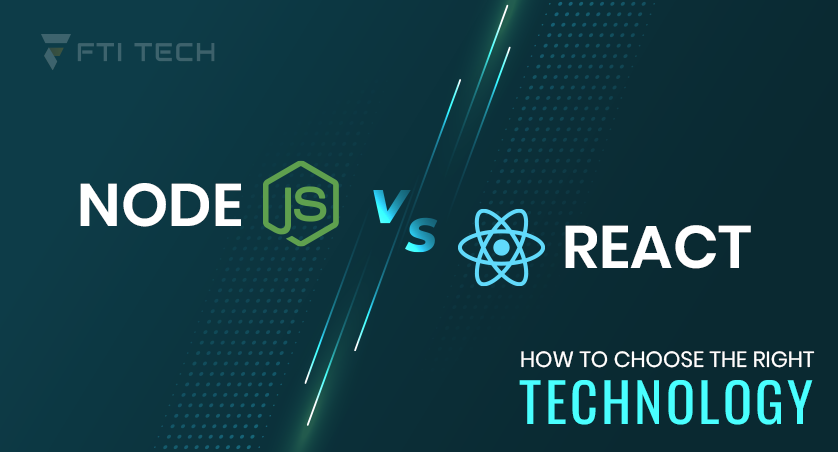Node.js vs React.js: Which One Should You Choose for Your Business?
React.js and Node.js are not just competitors to JavaScript frameworks, but two technologies that solve different parts of your web architecture puzzle. Node.js powers the server side logic and React helps you build the interface that enhances the user experience.
So, it doesn’t become a question of choosing between them? But rather of understanding how they work together.
Then again, why compare them?
There is nothing complicated about that: every single web development process is individual, and the comparison between Node.js and React.js can assist you in understanding how either of them suits your needs. Specifically, it provides an option to select the tech stack you can use to build a site.
This blog provides a step-by-step comparison between Node.js and React.js. It also explains the operation of each technology, its applications, and the advantages of combining them.
Node.js vs React.js: An Overview
To make the comparison between Node.js and React.js, one should be familiar with them. Both technologies have several advantages, and it is also significant to know how they operate and their technical benefits.
What is Node.js?
Node.js is a JavaScript runtime environment that relies on the V8 JavaScript engine. It is used for server-side code, allowing the website’s backend to be developed and a strong underlying architecture to be built.
How Does Node.js Work?
Node.js handles the processing of various requests at once. In addition, it is good at making use of the non-blocking I/O model for parallel processing. Besides that, it is event-driven, which implies that you can create API-first applications with distinct services and active functionalities.
This feature of Node.js provides it with numerous benefits regarding concurrency and scale relative to other backend environments. Node.js is often paired with backend frameworks such as Express.js, which is backed with server-side development expertise and a non-blocking asynchronous I/O model, and hence is suggested to the backend.
Node.js also provides the use of Node Package Manager (NPM) to use open-source libraries and tools in developing a web project. With minimal resources, it can accomplish a powerful and efficient web experience with its huge ecosystem made from packages.
What is React.js?
React.js is a JavaScript library that is broadly used to generate the UI of any web application or website. It is modular and component based. Thus, it is possible to develop a better user experience without great investments, especially when paired with expert website development services. Also, it is more efficient because of the declarative programming features.
This means you can just declare the UI components and React automatically manages the state, updating the DOM efficiently.
How Does React.js Work?
React is a library whose basic principle is its partitioned structure. Therefore, the UI’s one part could be modified without the whole interface’s state being affected. This is the result of using the Virtual DOM, which enables React to make minor adjustments. Furthermore, modularity also opens a door for mixing different UI elements together.
One more benefit that React brings to your project is its declarative programming capability. It lets you state how a UI component is to be conducted and updates the user interface automatically in that context. There is no need for you to be concerned about managing states or the intricacies of frontend updates.
Architectural Roles of Both Technologies in the Web Stack
Node.js is a server-side runtime that concurrently operates all requests, while React is a user interface library that works on the user’s browser and controls the user’s communication with your frontend. You can benefit from the full-stack possibilities of MERN through Node.js and React, a practical approach that teams at FTI Tech often implement when building scalable, database-driven applications. This enables you to implement MongoDB and use Express.js along with other technologies.
Node.js vs React.js: Comprehensive Comparison
Here you have a detailed comparison between Node.js and React.js for your web development projects.
| Aspect | Node.js | React.js |
|---|---|---|
| Primary role | Server-side runtime to build APIs and backend services | Client-side library to build interactive UIs |
| Core mechanism | Event loop with non‑blocking I/O for concurrency | Virtual DOM diffing and reconciliation for efficient rendering |
| Typical use | APIs, microservices, real-time chat | SPAs, dashboards, high‑interaction front ends |
| Strengths | Handles many concurrent requests with low overhead | Component reuse, fast updates, predictable UI state |
| Limitations | Less suited for CPU‑bound tasks without offloading | Not a full framework; relies on ecosystem tools |
You know the comparison of Node.js vs React.js, how each of them works, their technical advantage, and the comprehensive differences. But when to use what technology? Here is the answer!
When to Choose Node.js vs React.js
When to Choose Node.js?
Choosing Node.js makes sense when you need a robust backend for your website, web app, or apps. Use Node.js when,
- You need to build a chat feature or a collaborative platform.
- You need to create a streaming platform for audio or video content.
- You want an API-first platform with asynchronous I/O.
When to Choose React.js?
React is the best choice if you are looking for dynamic UIs and interfaces that can adapt in real-time. So, choose React if,
- You need a highly interactive interface for your web apps.
- You want to create single-page applications and dashboards.
- You need to build customer-facing interfaces.
When to Combine Both?
Integrating React and Node.js together signifies that you are seeking full-stack capabilities. Therefore, use these technologies when,
- You want to leverage the MERN stack for your project.
- You require smooth integration with a database.
Wrapping it Up
The distinction between Node.js and React.js is evident: one is a backend technology for a robust system, while the other is a frontend technology with a dynamic UI. However, the total of both provides a full-stack capability that is not just for any web app, but rather for high-performance ones.
The merger of these technologies, known as the MERN stack, is going to significantly enhance user experience. Hence, it is a good idea to determine the most favorable conditions for utilizing Node.js and React to maximize the benefits of both technologies. If you’re exploring how Node.js or React.js could align with your next project architecture, you can contact us for guidance based on your specific goals.



